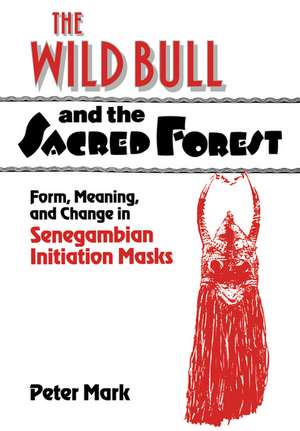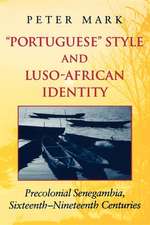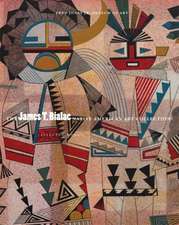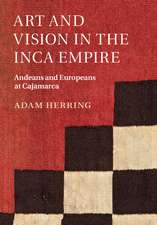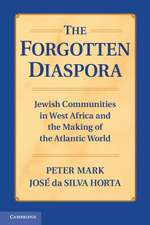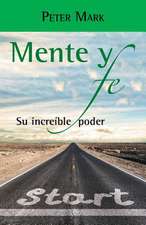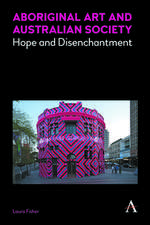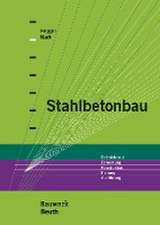The Wild Bull and the Sacred Forest: Form, Meaning, and Change in Senegambian Initiation Masks: Res Monographs in Anthropology and Aesthetics
Autor Peter Marken Limba Engleză Paperback – 16 feb 2011
| Toate formatele și edițiile | Preț | Express |
|---|---|---|
| Paperback (1) | 281.88 lei 6-8 săpt. | |
| Cambridge University Press – 16 feb 2011 | 281.88 lei 6-8 săpt. | |
| Hardback (1) | 813.93 lei 6-8 săpt. | |
| Cambridge University Press – 27 feb 1992 | 813.93 lei 6-8 săpt. |
Preț: 281.88 lei
Nou
Puncte Express: 423
Preț estimativ în valută:
53.94€ • 56.32$ • 44.54£
53.94€ • 56.32$ • 44.54£
Carte tipărită la comandă
Livrare economică 15-29 aprilie
Preluare comenzi: 021 569.72.76
Specificații
ISBN-13: 9780521180870
ISBN-10: 0521180872
Pagini: 190
Dimensiuni: 170 x 244 x 10 mm
Greutate: 0.31 kg
Editura: Cambridge University Press
Colecția Cambridge University Press
Seria Res Monographs in Anthropology and Aesthetics
Locul publicării:New York, United States
ISBN-10: 0521180872
Pagini: 190
Dimensiuni: 170 x 244 x 10 mm
Greutate: 0.31 kg
Editura: Cambridge University Press
Colecția Cambridge University Press
Seria Res Monographs in Anthropology and Aesthetics
Locul publicării:New York, United States
Cuprins
Foreword; List of illustrations; Acknowledgements; 1. Introduction: method and subject; 2. Ethnographic background; 3. Bukut initiation; 4. History and provenance of the Ejumba mask; 5. Iconography of the horned mask; 6. Mandinka or Jola? Art and culture as regional processes; 7. Islam and Casamance masking traditions; 8. Conclusion; Appendix; Bibliography.
Recenzii
"Clearly, Mark has provided great service in preserving for the ethnographic record documentation on masks that are apparently rapidly deteriorating. These masks have also provided Mark with a wonderful vehicle for the publication of valuable materials on the history of the Casamance. As a scholar of the Basse-Casamance, I found the detailed and extensive discussion of the region's history extremely well informed and engaging." Museum Anthropology
"Peter Mark provides us with an excellent study into the meaning and evolution of horned masking among the Jola and other groups of the Casamance region of West Africa....there is much to be valued in Mark's study of Ejumba masking....His book is an impressive volume for which Mark deserves high praise." African Studies Review
"Peter Mark's excellent study of the initiation masks and rituals of the Jola people in the Casamance region of Senegal has made a major contribution to the fields of art history and religion....Besides its interdisciplinary approach, Mark's study is innovative in a number of ways....This book is highly recommended to advanced undergraduates, graduate students, and scholars of religion and art history, as well as to Africanists in any disipline." Journal of the American Academy of Religion
"Mark has done a masterful job of tracking down over sixty such masks on three continents, unraveling the often complex history of particular masks, and supplementing them with his thorough knowledge of early European travellers' accounts which provide, occasionally with illustrations, the earliest evidence of such masks among the Diola. He skillfully interprets the changing iconography of the masks, relating them to Diola thought about manhood, fertility, witchcraft, and clairvoyance as well as the openness of Diola maskmakers to incorporate Muslim gris-gris (or shapes that imitate such talismen), Manjaco cloth, and even such commercial items as cowry shells and buttons into the decoration of the masks." Robert M. Baum, Journal of Religion in Africa
"Peter Mark provides us with an excellent study into the meaning and evolution of horned masking among the Jola and other groups of the Casamance region of West Africa....there is much to be valued in Mark's study of Ejumba masking....His book is an impressive volume for which Mark deserves high praise." African Studies Review
"Peter Mark's excellent study of the initiation masks and rituals of the Jola people in the Casamance region of Senegal has made a major contribution to the fields of art history and religion....Besides its interdisciplinary approach, Mark's study is innovative in a number of ways....This book is highly recommended to advanced undergraduates, graduate students, and scholars of religion and art history, as well as to Africanists in any disipline." Journal of the American Academy of Religion
"Mark has done a masterful job of tracking down over sixty such masks on three continents, unraveling the often complex history of particular masks, and supplementing them with his thorough knowledge of early European travellers' accounts which provide, occasionally with illustrations, the earliest evidence of such masks among the Diola. He skillfully interprets the changing iconography of the masks, relating them to Diola thought about manhood, fertility, witchcraft, and clairvoyance as well as the openness of Diola maskmakers to incorporate Muslim gris-gris (or shapes that imitate such talismen), Manjaco cloth, and even such commercial items as cowry shells and buttons into the decoration of the masks." Robert M. Baum, Journal of Religion in Africa
Descriere
This study of the cattle-horned initiation masks of southern Senegal and the Gambia gives a detailed view of Casamance cultures.
